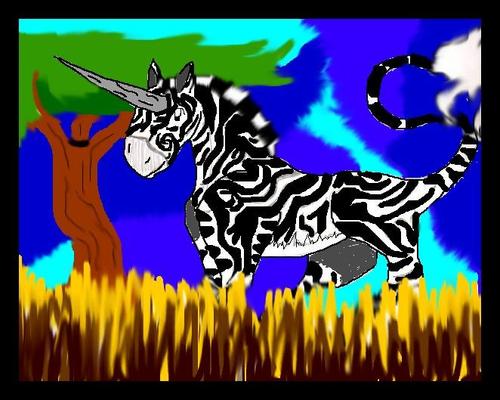The Earliest African Unicorn Evidence November 8, 2014
Author: Beach Combing | in : Ancient, Medieval , trackbackThis blog, several years ago, ran a series of posts on unicorns. Here is a late appendix based on reading Cosmas Indicopleustes’ Christian Topography, a work that dated to the mid sixth century of our era. Cosmas was a widely travelled Greek. He had been to Ethiopia and he may have been to Sri Lanka, he had certainly spoken to men who knew the island well. This is what he has to say about the unicorn, an animal he includes in a list of exotic but real creatures.
This animal is called the unicorn, but I cannot say that I have seen him. But I have seen four brazen figures of him set up in the four-towered palace of the King of Ethiopia. From these figures I have been able to draw him as you see [the original image of course is lost]. They speak of him as a terrible beast and quite invincible, and say that all his strength lies in his horn. When he finds himself pursued by many hunters and on the point of being caught, he springs up to the top of some precipice whence he throws himself down and in the descent turns a somersault so that the horn sustains all the shock of the fall, and he escapes unhurt. And scripture in like manner speaks concerning him, saying, Save me from the mouth of lions, and my humility from the horns of unicorns. And again: And he that is beloved as the son of unicorns, and again in the blessings of Balaam wherewith he blessed Israel, he says for the second time: God so led him out of Egypt even as the glory of the unicorn; thus bearing complete testimony to the strength, audacity, and glory of the animal.
The Biblical references at the end are controversial (is it really a unicorn being described in the Hebrew?) and they will be left for the future: another day, another post. However, the Ethiopian lore about the unicorn is fascinating and is good proof that the unicorn was being celebrated as early as the sixth century AD to the south of Egypt. Cosmas notes that he had not himself seen the unicorn (whereas he had seen the rhinoceros, albeit at a distance, and later a stuffed rhinoceros) but he had seen these mysterious brazen figures. What were these brazen figures. Two possibilities. They may first have been animals on a bronze panel: there is always the danger in unicorn spotting that a unicorn is discovered in a two dimensional image simply because a quadroped with two horns is shown in profile and so appears or can be construed as a unicorn. Alternatively, the brazen images may have been unicorn statues. The first possibility is surely the most likely. As to the nonsense about the horn breaking the shock have no idea what to make of that: to the best of Beach’s knowledge it is unprecedented. drbeachcombing AT yahoo DOT com Note that Cosmas seems to have misunderstood the nature of the rhinoceros’ horns too: ‘When he is walking his horns are mobile, but when he sees anything to move his rage, he erects them and they become so rigid that they are strong enough to tear up even trees by the root, those especially which come right before him.’



